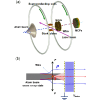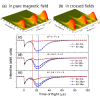Abstract
We report the observation of a controlled Landau-Zener transition (LZT) in Rydberg atoms by breaking the symmetry of the underlying Hamiltonian. For a nonhydrogenic Rydberg atom inside a changing electric (F) field, a LZT occurs between the avoided crossing energy levels of neighboring Rydberg states only for a sufficiently high changing rate. If a transverse magnetic (B) field is applied as we implement, the atomic level symmetry is broken, which causes the Stark manifolds denoted by a different |m| (m is the magnetic quantum number) to interact with each other. The mixed state levels end up pushing the adiabatically repelled target states closer and additionally they serve as stepping stones for the sequential LZTs between the neighboring sublevels. Such a feature significantly decreases the changing rate required for an efficient LZT inside a pure electric field. We report experimental observations that support the above scenario. It opens a versatile approach for engineering a controlled LZT in more general systems.
 |  |  |
 |  |
DOI: 10.1103/PhysRevLett.120.063203
https://pubmed.ncbi.nlm.nih.gov/29481261/
Supported by the National Key Basic Research and Development Program and the National Natural Science Foundation of China.





